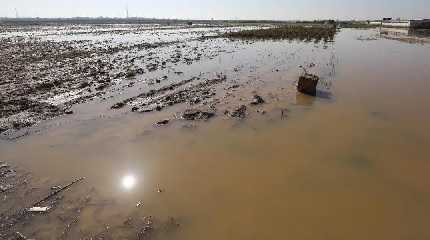
LOS ANGELES, Aug. 14 (Xinhua) -- Global warming has significantly increased the risk of "mega-flooding" in California and the Western United States, a UCLA study published in the journal of Science Advances on Friday said.
The study, co-authored by climate scientists Xingying Huang and Daniel Swain, and co-funded by the California Department of Water Resources, warned that this future deluge could be as devastating as California's "Great Flood" of 1862, in which over 30 days of unceasing rain unleashed a flood of biblical proportions that left California's Central Valley underwater.
In 1862, the entire valley, an area covering 13,000 to 16,000 kilometers, was inundated by water with depths up to 30 feet (9.1 meters), completely submerging telegraph poles that had just been installed between San Francisco and New York.
But the stakes are astronomically higher now, the researchers warned. A flood of that magnitude today would inundate parts of Los Angeles, Fresno, Stockton and Sacramento and overwhelm the levees, water shunts, storm drains and reservoirs that comprise California's extensive water system.
"Every major population center in California would get hit at once -- probably parts of Nevada and other adjacent states, too," warned study co-author Swain.
And with a state population soaring from 500,000 in 1862 to 40 million in 2022, a mega-flood could potentially displace up to 10 million people. In 1862, at least 4,000 people were estimated to have been killed in the floods, roughly 1 percent of the state population at the time.
It would also wipe out an entire season of food crops grown in America's California-based breadbasket -- the Central Valley -- which produces one-quarter of the nation's food supply and 40 percent of its nuts and fruits.
Swain also predicted massive effects on California's infrastructure and relief efforts, such as the prolonged closure of major interstate freeways like I-5 and 1-80. This would create a ripple effect in supply chains and economies worldwide.
Some estimate it could cause a 1-trillion-U.S.-dollar natural disaster, the largest in history.
Swain warned future mega-floods could be more devastating than the "ARkStorm scenario that devastated the Central valley 160 years ago," predicting that "more rain overall, more intense rainfall on an hourly basis and stronger wind" could happen.
To account for the additional flood-worsening effects of climate change, scientists from UCLA and the National Center for Atmospheric Research have completed the first part of ARkStorm 2.0., a comprehensive plan to prepare for devastating floods.
Using a combination of existing climate models and cutting-edge, high-resolution weather modeling, the study also indicated that climate change had already doubled the chances of a mega-storm event in California and that those risks continued to rise with each degree the globe warms.
The science behind this is chilling: steadily increasing temperatures of a warming planet cause the Earth's atmosphere to store larger and larger amounts of water. This atmospheric saturation, in turn, leads to two disastrous outcomes: extreme drought or extreme releases of water in deluges fueled by "atmospheric rivers," which are condensed water vapor carried aloft in the atmosphere in long, thin streams.
In areas already devastated by wildfires, flooding would lead to catastrophic landslides and debris flows that could sweep away entire houses in their path.
The reoccurring cycles of drought and flooding caused by atmospheric rivers would present heightened challenges for the water and reservoir industry seeking to balance the pressing need for both flood control and water storage solutions.
"California will increasingly have to depend on potentially hazardous atmospheric rivers and flood water for water resource generation in a warming climate." said climate scientist Alexander Gershunov at the Scripps Institution for Oceanography in San Diego.
Karla Nemeth, director of the California Department of Water Resources, said her department will "identify the risks, seek resources, support the Central Valley Flood Protection Plan, and help educate all Californians, so we can understand the risk of flooding in our communities and be prepared."
Swain said the California Department of Water Resources would do more research using advanced flood simulations and develop workable response scenarios to a natural disaster of that scale. He added that collaborations with key strategic partners, such as the Federal Emergency Management Agency and the California Office of Emergency Services, are also being mapped out.




